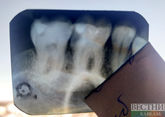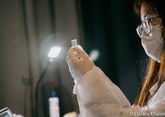An international research team led by Dr Sebastian Kruss from the Institute of Physical Chemistry at the University of Göttingen has produced a new nanomaterial based on the Egyptian blue pigment, which is ideally suited for applications in imaging using near infrared spectroscopy and microscopy. The results have been published in the journal Nature Communications.
The researchers say Egyptian blue is ideally suited for applications in imaging using “near infrared (NIR) spectroscopy and microscopy,” which according to Zeiss is based on the absorption of electromagnetic (EM) radiation when light interacts with a sample and a detector measures its transmittance and absorbance.
Egyptian blue, or properly, “calcium copper silicate,” is one of the earliest artificial pigments created by humans and the oldest known sample is from about 5000 years old, discovered in a tomb painting dated to the reign of Ka-Sen, the last pharaoh of the First Dynasty.
Dr. Kruss said microscopy and optical imaging are important tools in basic research and biomedicine, when light relating substances are excited and release “fluorophores” and these substances stain tiny structures in samples, enabling clear resolution using modern microscopes.
Most fluorophores shine in the range of light in the near infrared spectrum with a wavelength starting at “800 nanometers,” penetrating deep into tissue, therefore, fewer distortions are found in images. And so far, according to the new paper, there are only a few known fluorophores that work in the near infrared spectrum.
The research team’s big achievement was in exfoliating extremely thin layers from grains of calcium copper silicate, Egyptian blue pigment, and these particular nanosheets are “100,000 times thinner than a human hair” and in the near infrared range, which according to Dr Sebastian Kruss, makes them “ideal for optical imaging.”
Egyptian blue emits infrared light when red light is shone onto it, and while it’s an extraordinarily powerful and long-lived light, it cannot be seen by the naked eye, being too deep in the infrared range of the light spectrum.
The scientists followed the movement of individual nanosheets in order to visualize mechanical processes in the structure of animal and plant tissues, for example, in the cell nuclei of the fruit fly. Furthermore, the researchers integrated the nanosheets into plants and identified them without a microscope, which the paper says promises future applications in the agricultural industry. And Dr Kruss said the potential for state-of-the-art microscopy from this material means that new findings in biomedical research can be expected in the future.
Egyptian blue has a new role in advanced biomedical imaging with its near-infrared radiation being able to penetrate through tissue more effectively than other wavelengths, and for this same reason, because Egyptian blue splits into ‘nanosheets’ – a thousand times thinner than a human hair – if stirred in warm water for several days, it might serve as a future communication system as its emissions are similar to those used in remote controls and telecommunication devices.










